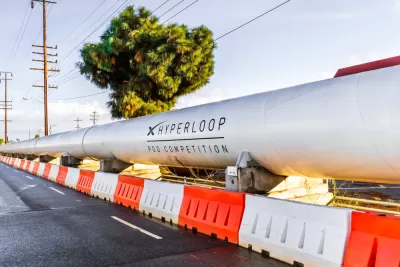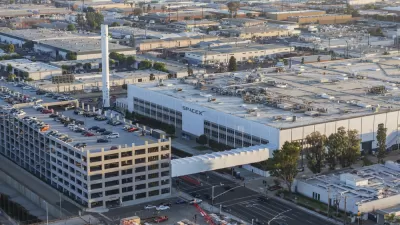After blocking sidewalk access for years, a tube segment in front of SpaceX’s Hawthorne office was removed at the city’s request, signaling a broader retreat from the project.

A tube that, for six years, hosted a variety of experimental transportation solutions that would theoretically have become Elon Musk’s Hyperloop has been removed from the right-of-way in front of SpaceX’s Hawthorne, California office.
As Jonah Valdez reports for the Los Angeles Times, the city received complaints about the tube, which residents claimed blocked pedestrian access. “The tube took up an eastbound lane heading toward Crenshaw Avenue, complicating existing concerns in the busy area about traffic congestion, drivers traveling at freeway speeds and pedestrian safety.” Multiple SpaceX employees were also hit by vehicles while crossing the street, prompting the company to build a pedestrian bridge to its parking garage.
While representatives for SpaceX and Boring Co. did not respond to inquiries, Bloomberg reported earlier this week that the Hyperloop “has been indefinitely shelved.” Local officials are unsure whether a mile-long underground test tunnel is still in use. Hawthorne City Attorney Robert Kim says the company is required to backfill the tunnel when testing is complete. “More recently, Musk backed out of a tunnel project that would have transported riders from the Rancho Cucamonga Metrolink station to Ontario International Airport. San Bernardino County transit officials plan to carry on the project without him.”
FULL STORY: Elon Musk's Hyperloop prototype tunnel removed in Hawthorne

Planetizen Federal Action Tracker
A weekly monitor of how Trump’s orders and actions are impacting planners and planning in America.

San Francisco's School District Spent $105M To Build Affordable Housing for Teachers — And That's Just the Beginning
SFUSD joins a growing list of school districts using their land holdings to address housing affordability challenges faced by their own employees.

The Tiny, Adorable $7,000 Car Turning Japan Onto EVs
The single seat Mibot charges from a regular plug as quickly as an iPad, and is about half the price of an average EV.

Seattle's Plan for Adopting Driverless Cars
Equity, safety, accessibility and affordability are front of mind as the city prepares for robotaxis and other autonomous vehicles.

As Trump Phases Out FEMA, Is It Time to Flee the Floodplains?
With less federal funding available for disaster relief efforts, the need to relocate at-risk communities is more urgent than ever.

With Protected Lanes, 460% More People Commute by Bike
For those needing more ammo, more data proving what we already knew is here.
Urban Design for Planners 1: Software Tools
This six-course series explores essential urban design concepts using open source software and equips planners with the tools they need to participate fully in the urban design process.
Planning for Universal Design
Learn the tools for implementing Universal Design in planning regulations.
Smith Gee Studio
City of Charlotte
City of Camden Redevelopment Agency
City of Astoria
Transportation Research & Education Center (TREC) at Portland State University
US High Speed Rail Association
City of Camden Redevelopment Agency
Municipality of Princeton (NJ)




























